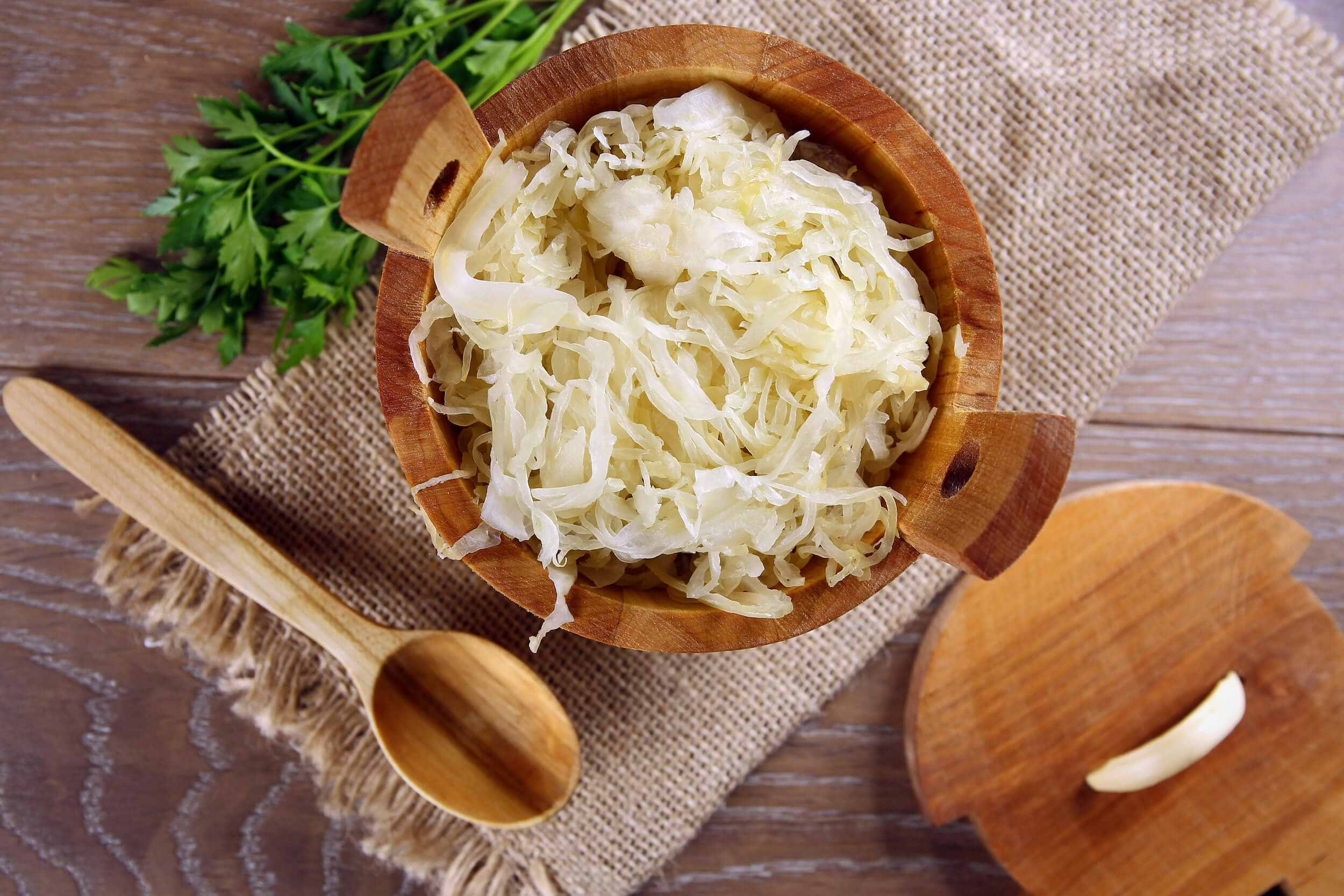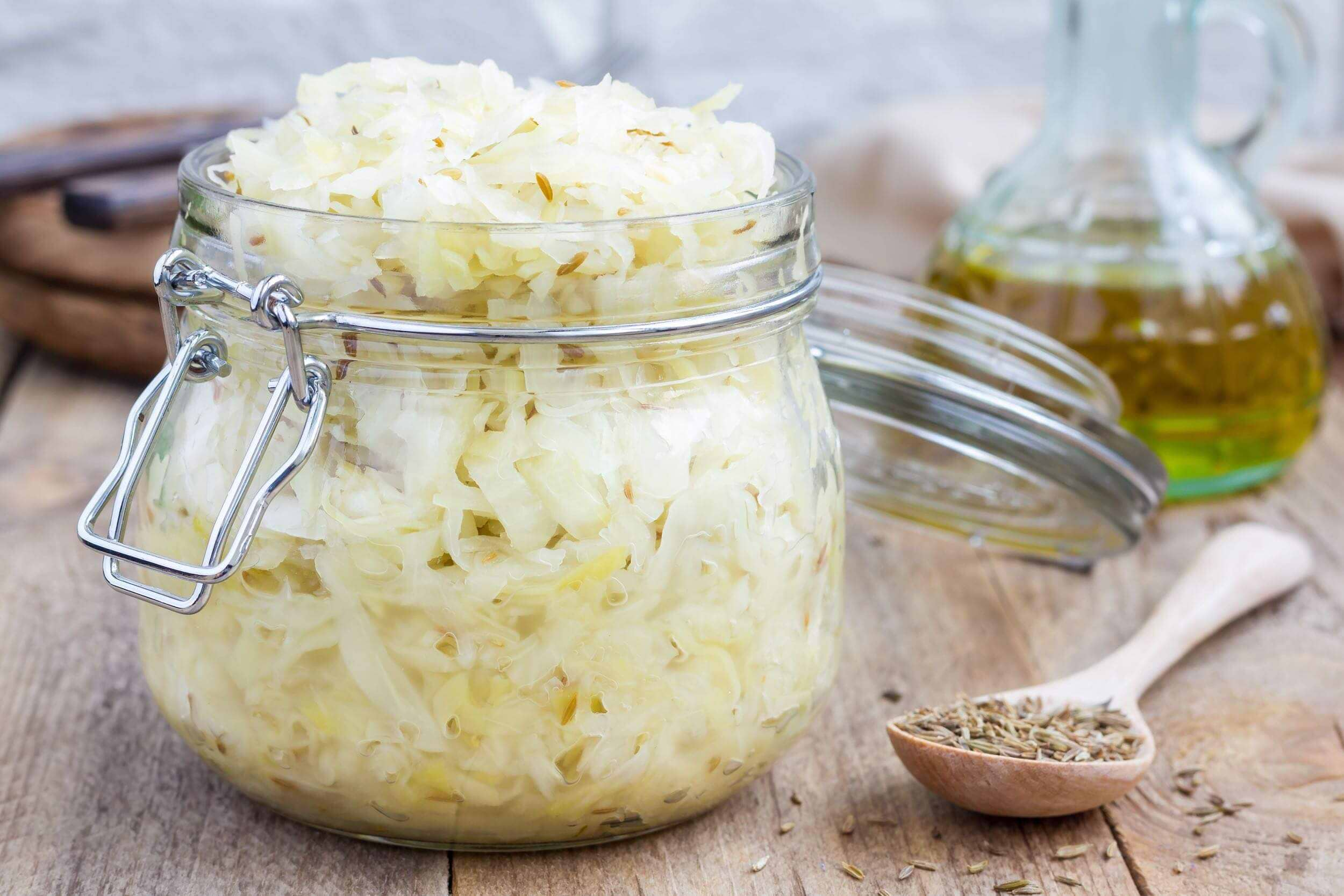Welcome to thoughtful, organic beauty
Hello Joyous is an organic, plant-based, sustainable beauty brand here to bring more joy to your day.
Sauerkraut is one of the oldest and most popular fermented foods. Even though sauerkraut is German for "sour cabbage", it actually originated in China thousands of years ago! It’s a very sensible superfood because when the cooler months hit, sauerkraut was a reliable source of nutrients when fresh fruits and veggies were scarce because no one had a refrigerator back then.
 (And yes, I've been eating a LOT of sauerkraut here in Austria – it's on pretty much every plate of food when we eat out at restaurants. Follow along with my adventures on Instagram!)
(And yes, I've been eating a LOT of sauerkraut here in Austria – it's on pretty much every plate of food when we eat out at restaurants. Follow along with my adventures on Instagram!)
Sauerkraut is one of those foods that's often considered mysterious because many people have no idea how it's made and assume it's a rather complicated process. I used to be intimidated by it (just like I was once intimidated to make my own yogurt !) until I made it for myself. I'm here to bust that myth and tell you how incredibly easy it is!
Once you see the process in my video, you'll realize sauerkraut is the furthest thing from mysterious.
I guess the mystique comes from the fact that it’s quite magical how the bacteria transform raw cabbage into a delicious and tangy kraut that's a superfood for your gut health. Superfoods for gut health benefit your microbiome , which impacts every system in your body from your immunity to your metabolism. Kraut is great for kids, too, and supports their microbiome as well! My daughter Vienna absolutely loves it as a side dish.
I talk about the health benefits of kraut in my video, as well as how to enjoy it, but I've written a more comprehensive summary below.
HEALTH BENEFITS OF SAUERKRAUT
Gut health: Rich in live probiotics that support your whole-body health such as Leuconostoc mesenteroides, Lactobacillus plantarum (this strain is in the kiddie probiotic that I give to Vienna every day), Pediococcus pentosaceus, and Lactobacillus brevis. More recent studies have uncovered even more bacteria than these four strains but it will also depend on a variety of other factors. My sauerkraut may differ from the kraut you make in, say, Hawaii, that's because of the temp in your home, the cabbage you’re using, etc.
But why does this matter? These various strains of probiotics help make foods more digestible and increase your gut’s ability to
absorb nutrients.
The more diverse the bacteria in your gut, the healthier your body, which is why consuming fermented foods is an excellent addition to supporting the health of your microbiome.
Immune health: The probiotics, vitamin C, iron and hundreds of phytonutrients in sauerkraut enhance your immune system. 80% of your immunity resides in your gut so the bacteria that live there can either dampen or enhance your immune system. This is because they maintain the integrity of the intestinal wall. Leaky gut is a perfect example of a condition where the microbes are not doing their job and the tight junctions in the gut have become loose letting food molecules and other bacteria in – this when the immune system gets compromised.

Cancer prevention: Cabbage is considered a cancer prevention superfood because it contains phytonutrients such as glucosinolates that enhance detoxification of certain carcinogenic enzymes and are toxic to many types of cancer cells. In fact, the consumption of cruciferous veggies has been linked in many studies with inhibiting the development of breast cancer. And evidence shows that eating them regularly lowers your risk of developing many different types of cancer. So if you’re not munching on sauerkraut, then make this Turmeric Cauliflower Rice or my Roasted Cauliflower Salad or Walker’s Spicy Brussels Sprouts from first cookbook Joyous Health!
Nutrient-dense: You’ve probably heard me say before that when a food is fermented it becomes biotransformed! That’s fancy for saying it becomes a whole entire new food because bacteria do this magical thing to nutrients in food.
For instance, cabbage has about 30 mg of Vitamin C per cup but when it’s fermented it can have up to 600 mg per cup – incredible right?
Then there’s vitamin K2, which over the last 10 years since I became a nutritionist I’ve seen this nutrient soar to popularity as research has revealed its importance for long-term bone health. This is because it has an ability to assist calcium and other minerals to bind into the bone matrix thereby strengthening bones. Vitamin K2, similar to vitamin D is not in many foods. You'll find it in many animal foods and fermented foods. And, cool fact – it's made by your gut bacteria too!
Here’s the recipe!
The amount of cabbage this recipe makes really depends on the size of the cabbage you start with. As you can see in my video, I started with a very large cabbage and this filled a large mason jar (32 oz/1 quart). I would suggest you have a couple of sizes on hand. You could also do 2 x small 16oz jars. It's up to you!
*Please choose organic, there will be more good bacteria present on the cabbage to help it ferment.
If you’re a sauerkraut virgin, leave your doubts at the door because you can do this - it's so easy!! You’ll be so proud of your kraut once enjoy the fruits of your labour! And if you're excited about making your own ferments, you must try these recipes next:
If you have more questions after watching this video, please comment below and I’d be happy to answer them.
Happy fermenting!
Joy xo
So, I've tried to make sauerkraut twice now and failed miserably. I'm shaming my grandmother since she made big vats of it and, as a kid, my dad would step on the sauerkraut to press it down. You're right, they ate it all winter long. I LOVE it, and eat it pretty much everyday. Thanks for the inspo! It's great beside bratwurst. I'm sure your husband would agree :)
ReplySorry to hear you failed at your kraut batches, try my recipe and let me know what you think! Yes, my hubs loves bratwurst :)
Mold developed on the top of my brine, is this normal?
ReplyIt can happen. How long did you leave it out for? You can scoop it off, it probably hasn't spoiled the whole thing.
If you are adding things to your sauerkraut, like apples, do you add them after the sauerkraut has finished the fermentation process?
ReplyNope! You add them while you're making it. You can check out this recipe here: https://www.joyoushealth.com/18161-blog-crunch-tastic-sauerkraut-recipe
I used Savoy Cabbage ... will see how this works : )
ReplyLet me know! I would imagine it will work out great :)
this gave me so much confidence to make my own! it always seems so intimidating but you made it clear in the video :) THANKS!
ReplyHi Nicole, that's exactly what I was hoping! Enjoy!
Ty Joy, very good job! What about adding some caraway and bayleafs? And we should not forget, besides the vitamins and bacteriae, a good sauerkraut has beneficial acids and minerals as well.
ReplyYes love that addition!
Sorry, I forgot to mention juniper berries, they may block the acid attack in the stomach.
ReplyHI Joy, can I use red cabbage?
ReplyAbsolutely!
Hello, I'm planning to do your recipe and I was wondering once we opened the jar, how long does it keep in the fridge?
ReplyAs long as it's kept in the fridge, sauerkraut shouldn't go back because the fermentation stops with the cold temperature.
Hi Joy Thank you so much for the recipe. The problem is that I stay in Singapore and the temperature is always 27c to 32c.May I know what can do. I read from somewhere low temperature fermentation is better, is that right? Since it is always so hot here, I am worry it will turn bad, how does a good fermentation taste and smell like? Tangy? Thank You Fen
ReplyNot necessarily. It will probably ferment faster in a warmer temperature which isn't a bad thing you'll just have to pay closer attention to it! Sounds like a lovely temperature! It's still only about 10c tops in Toronto. I can't wait for summer!
Hi my name is Lila and I really love Sauerkraut. Unfortunately I've Had to purchase it from the Market. Today my Daughter, Venus took me shopping at BJ's to purchase it in bulk. I was shocked 😲 and disappointed 😞 that that store doesn't carry it anymore. I saw your recipe and would love to see your video. Please send me the link to it. I'm not as technical savvy as my Daughter so I might have to be handled with kids 😅 gloves. Thks. Much. Lila
ReplyHi Lila! Kraut is so easy to make yourself!! Here's my recipe: https://www.youtube.com/watch?v=a1FsFR522go&t=7s
Hi my name is Lila. I recently purchased your book "Joyous Detox" mainly for your sauerkraut recipe. I'm very disappointed because the recipe on page 205 in the book is not the same as the one on your YouTube video. The one in the book includes Carrots and Apples. I'm not pleased at all in fact I'm so disappointed that I'm seriously thinking about returning the book.
ReplyHi Lila, sorry to hear you are disappointed. I have 100's of different recipes between my three cookbooks, my website, and YouTube. Can you help me understand why you are upset I have more than one sauerkraut recipe? The more the merrier!
It's Lila again. Why do you keep sending me the sauerkraut video and the health benefits of it. I did not asked you that question. I stated to you that the reason I purchased the book was because I wanted to see the exact same recipe as your video on page 205 as you indicate in the video. I plan on returning your book because you obviously don't plan on answering my question and as I stayed before, the only reason I purchased the book in the first place was for the sauerkraut recipe.
ReplyHi Lila, I'm not sure if you realize this, but the recipe in my book is the exact same method as this recipe. All I did was add some carrot and apple to create different variations but the recipe is the same. Once you have nailed your base recipe you can get creative and have fun with it. I'm sure you can return my book no problem if it's not to your liking. Everything is gonna be okay!
Hi it's Lila again and I'm getting very tired and frustrated Because you're asking me the name of the book I'm comparing the recipe with when I indicated the name in my last text. It's called "joyous detox" this is the book that you stated that the sauerkraut recipe would be in on page 205. There is a recipe on page 205 for sauerkraut but it includes apples and carrots and that's not the one I purchased the book for.
ReplyHi Joy, can raw chopped cabbage be frozen?
ReplyTo make the sauerkraut, you'd need to use fresh cabbage.
I try not to use salt, so this tasted extremely salty to me. Can I use less salt or rinse the kraut b4 eating? Or will this lose more of the nutrients? Otherwise I really like it.
ReplyThe salt is the natural preservative so you just have to be mindful of making it with less salt it may spoil more quickly.